VVAM Newsletter 82 – 2001
Friends of the Airborne Museum
Editors:
Drs. R.P.G.A. Voskuil
C. van Roekel G.H. Maassen jr.
Newsletter No. 82, May 2001
Translated by Cathrien and Peter Clark
Representative in Great Britain: Niall Cherry, 3 Church Road, Warton, Lancs, PR4 1BD Tel. home 0177-2632764
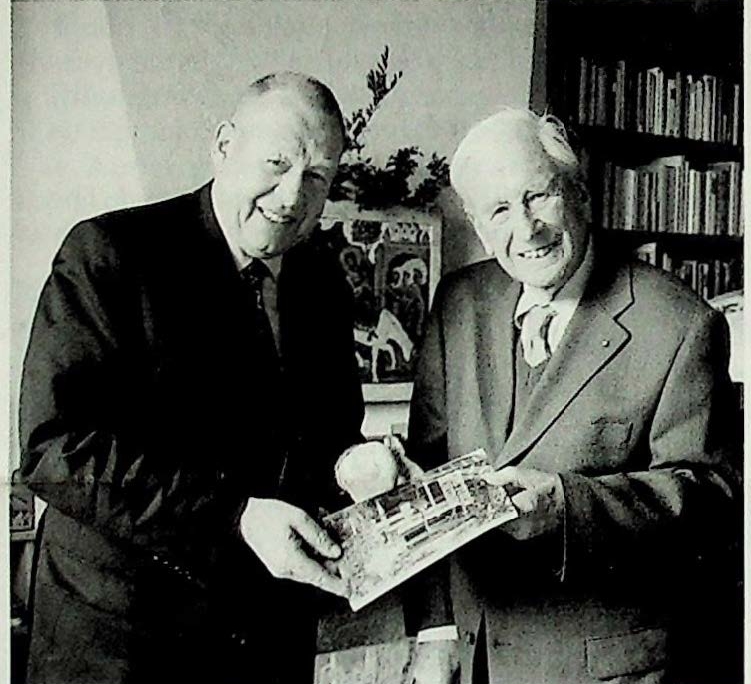 23 April 2001. Author Chris van Roekel hands the first copy of the book ‘The Torn Horizon’ to Mr Jan ter Horst, (photo: Ben Kolster)
23 April 2001. Author Chris van Roekel hands the first copy of the book ‘The Torn Horizon’ to Mr Jan ter Horst, (photo: Ben Kolster)
‘The Torn Horizon’
In 1998 our Society Chairman Chris van Roekel published a book about the British clergy who took part in the Battle of Arnhem entitled ‘Verscheurde Horizon’. This book generated a lot of interest in the United Kingdom and it was therefore decided to produce an English version under the title ‘The Torn Horizon, The Airborne Chaplains at Arnhem’.
All expenses for this issue were met by the Ter Horst family from Oosterbeek. During an informal meeting on 23 April last, the author presented the first copy to 96-year-old Mr Jan ter Horst. The Ter Horst family has decided that all profits from the book should go to the Anti-Landmine Foundation, an organisation that lobbies for the worldwide banning of landmines.
‘The Torn Horizon’ consists of 134 pages with 71 illustrations, and costs 35 guilders. Post and package (if required) cost 5 guilders extra. The book is on sale at the Airborne Museum ‘Hartenstein’.
New treasurer
At the AGM on 7 April 2001, Erik van der Meiden relinquished his post as Friends’ Society treasurer. He has held this position for the last four years and is succeeded by Frits Miedema.
For a temporary period Erik has offered to provide help and advice to the new treasurer and to our British representative Niall Cherry on a number of activities, because the financial administration of a large society, with members here and abroad, is extremely demanding both in time and effort. We thank Erik for all the work he has carried out with such care and accuracy over the past four years and for his readiness to continue assisting the society.
(Chris van Roekel, on behalf of the Board)
Many thanks!
During the AGM of 7 April last I handed over my function as treasurer in the management board of the Friends’ Society to Frits Miedema.
1 would like to take this opportunity of thanking everyone for the wonderful co-operation I have received over the last four years. My special thanks go to the volunteers who, through their efforts, keep society expenses as low as possible, and to Niall Cherry our British representative, who single-handedly and in addition to his hectic job, carries out all manner of tasks for our 400 members in the United Kingdom. For a short period 1 hope to be able to support Niall in financial matters.
I would also like to express the wish that your new treasurer, Frits Miedema, can depend on your continued co-operation. Once again, my heartfelt thanks!
(Erik van der Meiden)
Social Evening
A number of British members of the Friends’ Society will be visiting Oosterbeek during the weekend of 22, 23 and 24 June 2001. To mark this occasion a Social Evening will be held in the Airborne Museum on Friday evening 22 June. Dutch members are also invited to come along and make the acquaintance of some of their English colleagues and exchange views. During the evening, which begins at 7.30 pm, the library and depot will be open for ‘inspection’. Refreshments are at one’s own expense.
To assist the organisation, Dutch members wishing to attend this Social Evening are requested to notify Eugene Wijnhoud (Bernhardlaan 41-1, 6824 LE, Arnhem; tel. 026 3513100) before 18 June next.
From the AGM: the lift
You will doubtless be aware that your board has expressed strong views regarding the plans to fit a glass lift, for the less mobile among us, to the outside of the Airborne Museum.
You all know that some time back we made a plea in favour of retaining the front elevation of ‘De Tafelberg’ and part of the railway bridge over Klingelbeekseweg. It was here that Frost’s batallion suffered its first heavy losses in its advance into Arnhem on 17 September 1944. Traces of the hail of bullets they encountered are still clearly visible. It is in this light that our objections should be considered.
The issuing of a joint statement in an attempt to prevent the difference of opinion with the Airborne Museum Foundation from escalating into a situation that could sour the general co-operation regarding the museum has not, up to now, led to full consensus between the respective management boards.
A few days before the AGM it seemed that varying views on the declaration written by one of our board members still existed, but that the differences of opinion had largely been solved. Therefore our only alternative was simply to give you a declaration of the state of affairs as seen from our viewpoint. The following declaration was read out by Mr Ben Kolster at the AGM and should be regarded as an end to our ‘contribution’ in the matter, and to the discussion.
‘At present the Airborne Museum in Oosterbeek provides only limited access for the less able. The present provisions no longer meet today’s requirements, and so an improvement plan was compiled.
The management board of the Airborne Museum Foundation asked the newly formed Airlift Foundation (specially set up for the task) to look into the possibilities of accessibility for the less able and then to implement the necessary provisions. However, the management of the Society of Friends of the Airborne Museum sees the Airlift Foundation’s proposed design of a glass lift on the outside of the Airborne Museum as an impermissible tarnishing of the value as a monument of these historic premises. For this reason the management of the Society of Friends of the Airborne Museum came up with an alternative: a below-ground extension of the museum that would include a lift facility.
The plans led to heated discussions between the management boards of the Airborne Museum Foundation and the Society of Friends of the Airborne Museum regarding the path to follow. Each board was made aware of the other s arguments and motives, but nevertheless differences remained over the option to be implemented. The Airborne Museum Foundation’s board eventually decided to go ahead with the Airlift Foundation’s proposal of a glass lift on the outside of the building. They feel that a below-ground extension could not be realised within a reasonably foreseeable time, which itself would lead to a delay in the provision of facilities for the disabled. The museum board places much value on making the museum accessible within a very short time, something that seems possible with the Airlift Foundation’s proposed plan.
The museum board certainly recognises that a future below-ground extension is desirable for the quality of the museum. They also realise that, in the eyes of the Friends’ management, a glass lift as originally proposed would be a disproportionate blemish on the face of the ‘Hartenstein’ building.
Meanwhile, the lift design has been modified. The lift shaft will continue below ground level to such a depth that connection to a future extension under the ground will be a simple matter. The top floor of the building, that houses the documentation centre, offices and store room, will not be made accessible by lift. This will mean a shorter lift shaft that, as the museum board sees it, will make it less visually dominating.
The board of management of the Society of Friends of the Airborne Museum regret that their proposal was not subjected to an expert feasibility study and that their objections were only taken into account through a modification to the original plan. They remain opposed to the planned external lift, while at the same time recognising the responsibility and power of decision of the Airborne Museum Foundation, and therefore respect the decision that has been taken.
In mutual consultation, both boards have concluded that a facility for making the museum more easily accessible to the less able is of major importance for the museum, and the way this is achieved must not lead to a rift between them. The prime objective is that everyone works towards a qualitatively high- value museum with a clear message and accessibility for all. The discussion is therefore closed.’
Individual members wishing to help with the lift project can make a contribution to the Airlift Foundation in Oosterbeek.
Royal Engineers Exhibition
An exhibition dedicated to the British sappers during the Battle of Arnhem opened in the Airborne Museum on 23 April last. The opening ceremony was conducted by Mr E.C. O’Callaghan In September 1944 Mr O’Callaghan held the rank of captain in command of the 2nd Platoon, 9th (Airborne) Field Company Royal Engineers. This platoon fought at the Rhine Bridge in Arnhem from 17 to 20 September 1944.
Using photos, documents and artifacts, the exhibition gives a well laid out and interesting picture of the part the sappers played. The opening ceremony coincided with the official handing over to the Airborne Museum of the completely renovated Clark Air Bulldozer. The vehicle, which was paid for by the Society of Friends, has been given a place in one of the dioramas.
This occasion also saw the arrival of the book ‘Airborne Engineers, The Shiny 9th’ by Patrick Pronk (see below) and the brochure ‘De genie tijdens de Slag om Arnhem’ (The engineers during the Battle of Arnhem) by Martin Peters and Jaap Korsloot. In 16 pages the latter publication tells the story of the engineer units of the 1st Airborne Division during the Battle of Arnhem. The booklet follows the stages of the exhibition. It forms a useful addition to Patrick Pronk’s book and is published by R.N. Sigmond Publishing, and costs 7.50 guilders. The ‘Airborne Engineers, the sappers during the Battle of Arnhem’ exhibition continues until
4 November 2001.
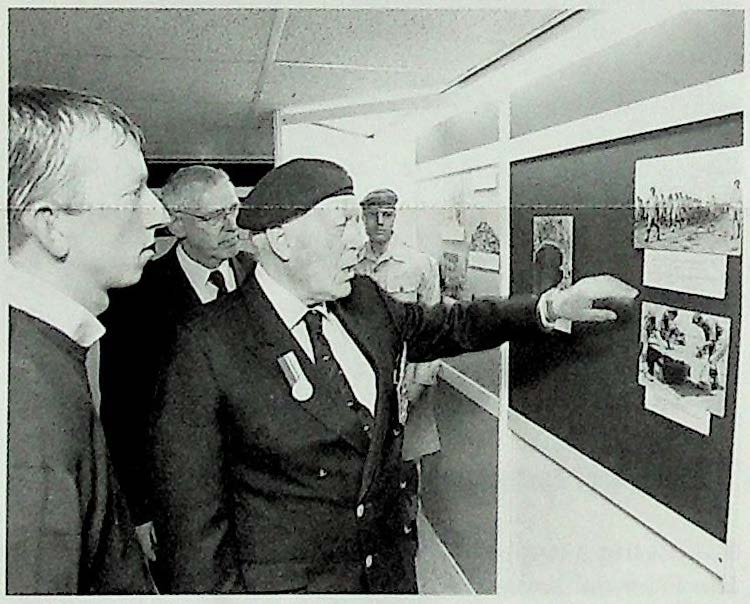 The author of the book ‘Airborne Engineers, The Shiny 9fh‘ Patrick Pronk and veteran Mr E.C. O’Callaghan study the exhibited photos during the opening of the Royal Engineers exhibition on 23 April last, (photo: Berry de Reus)
The author of the book ‘Airborne Engineers, The Shiny 9fh‘ Patrick Pronk and veteran Mr E.C. O’Callaghan study the exhibited photos during the opening of the Royal Engineers exhibition on 23 April last, (photo: Berry de Reus)
‘Airborne Engineers, The Shiny 9th’
There is still much to be told about the Battle of Arnhem. At least that is the conclusion we can draw from the ‘The Shiny 9th’, the book about the 9th (Airborne) Field Company Royal Engineers by Patrick Pronk, a Friend of the Airborne Museum. The 9th Field Company RE was, and still is, exceptional. Already a long-standing unit-raised in 1787 – it was one of the first Airborne units and is still ‘airborne’.
In the book we follow the company in the Second World War from its battles in France via Dunkirk, the ‘Home Army’, the beginning of its Airborne role, its part in the attack on the heavy water plant in Norway, North Africa, Sicily, Arnhem and, again, Norway. The compilers of the Royal Engineers Battlefield Tour and the authors Mackay, Pakenham- Walsh, Purves and Henniker have already written books about the Royal Engineers at Arnhem. Pronk’s book, in English, makes a nice addition to this list. The tasks allotted to the company at Arnhem were the support of the Reconnaissance Squadron’s Coup de Main force on its way to the Rhine Bridge, the removal of any demolition charges there (and at the railway bridge in Oosterbeek), followed by any job that might be expected of an engineers unit. In many instances this turned out to be an infantry role. After the landings we see (parts of) the company in the battle against Krafft’s SS Panzer Grenadier Battalion in Wolfheze, at the railway bridge in Oosterbeek, at the Rhine Bridge in Arnhem, around Huize De Sonnenberg and at the Old Church in Oosterbeek, at the Driel ferry, in the laying of white tapes marking one of the two routes for the withdrawal across the Rhine, and in captivity.
Pronk’s book is somewhat more personal than Purves’ ‘The 9th’ and has therefore more depth. The book is beautifully presented by Sigmond Publishing and is an easy read. ‘The Shiny 9th’ comprises 109 pages and costs / 27,50.
(Okko Luursema)
Rules for using the library
The Airborne Museum’s archive and library were recently transferred to their new location in the refurbished top floor of the ‘Hartenstein’.
In order to avoid any confusion it might be a good idea to repeat the regulations applying to use of the library and archive. These are open for everyone to consult after making a prior appointment with Mr A. Groeneweg. Books and documents cannot be taken out but copies can be ordered (at cost) provided they do not infringe copyright.
(A. Groeneweg)
Medal set
Recently, and for the first time, the Airborne Museum came into possession of a set of medals belonging to an ex-Royal Army Service Corps Air Despatcher, veteran Ronald Arthur Clancy, who died on 31 October 2000 at the age of 76.
As an R.A.S.C. Air Despatcher attached to the 6th British Airborne Division (63 Composite Company 6th Airlanding Brigade), Ron Clancy was involved in the re-supply of British troops in Normandy in June 1944. On 19 September 1944, during the Battle of Arnhem, he flew on a re-supply mission from Keevil to Oosterbeek. Next day he was again scheduled for a re-supply flight but his group was stood down at the last minute and replaced by another.
Ron Clancy was a co-instigator of the Air Despatch monument at Van Limburg Stirumweg in
Oosterbeek, which was unveiled in 1994. (Cees van den Bosch)
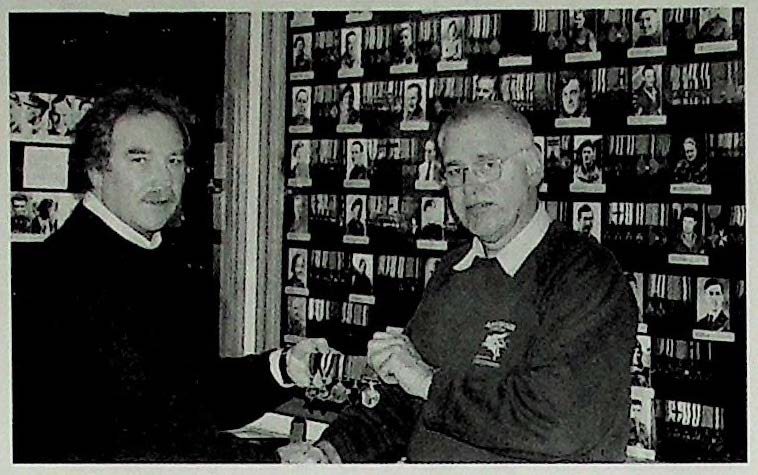 Director of the Airborne Museum Wybo Boersma receives ex-Air Despatcher Ron Clancy’s medals from the hands of Cees van den Bosch. Ron Clancy passed away in October last year.
Director of the Airborne Museum Wybo Boersma receives ex-Air Despatcher Ron Clancy’s medals from the hands of Cees van den Bosch. Ron Clancy passed away in October last year.
(photo via Wybo Boersma)
Fulbeck Hall
Fulbeck Hall in Lincolnshire, former headquarters of the 1st British Airborne Division, was, until recently, home to an exhibition on the Battle of Arnhem.
Following the death of its lady owner Mrs Mary Fry, the house has been closed and the exhibition dismantled. The material has been returned to the people from whom it was loaned.
A few veterans decided to donate their items to the Airborne Museum, and these include an inscribed metal plate that once stood in front of the Military Police nissen hut at Fulbeck Hall. The museum was also given a collection of photos and documents. (W. Boersma)
Fie received this major British decoration in recognition of all the work he has done in compiling the ‘Roll of Honour, Battle of Arnhem’ and for his research over many years resulting in the re-identification of around 40 dead servicemen who, until then, had no known grave. On top of all this he has been engaged for years in compiling the many ‘Rolls of Honour’ of all the British and Canadian divisions and their supporting units that took part in the liberation of Western Europe from D-Day onwards. These Rolls of Honour are to be found in the Memorial Hall of the Liberation Museum in Groesbeek.
The Society of Friends of the Airborne Museum would like to offer Jan Hey its warmest congratulations on receiving this well-deserved honour.
Appeal
Another of our members, David Truesdale, is currently working on a book about the experiences of Irish servicemen during the Battle of Arnhem. The book will be called ‘The Brotherhood of the
Cauldron’.
Up to now he has approximately 300 names of soldiers who were attached to the 1st British Airborne Division. He has the complete life story of some of these men, but of some of the others he has only a name.
David is therefore making an appeal to members of the Friends’ Society. Anyone who has any information about Irishmen who served with the division are kindly asked to contact David Truesdale, 16 Shiralee Drive, Newtownards, County Down, BT23 4BA, Northern Ireland; e-mail david@truesdale59.freeserve.co.uk.
Excavated finds
For more than twenty years, Society member Hans van der Velden from Doorwerth has been engaged in searching the former battlefields with a metal detector for remains of equipment from the Battle of Arnhem. Of course this is done with the permission of the owners of the land concerned.
Over the years Hans has come across some really exceptional items. In the past some of these finds were given to the ‘Hartenstein’ on loan. Now, thanks to generous financial support from the Friends’ Society, the Airborne Museum has been able to purchase the major part of Hans’ collection of excavated items, some of which have been included in the Royal Engineers exhibition.
Over the coming year Roland Boekhorst from the museum’s maintenance staff will preserve the other items so that they remain in good condition.
MBE for Jan Hey
Friends’ Society member Jan Hey has been awarded the MBE.
The Airborne Monument
Following a request at the AGM, the management of the Friends’ Society re-contacted Renkum council with regard to the state of the Airborne Monument opposite Hartenstein.
It appears that the council is well aware of what needs to be done to the monument. A repair and maintenance plan has been made which will be carried out in a number of stages. Money has been put aside for this purpose. An encouraging message.
Apology
The previous Ministory carried the number 68, oddly enough the same as the edition before. Obviously something went badly wrong.
Alas, this is not the first time that such an error has occurred, but fear not. The culprit(s) will be severely dealt with!!
Would you please be so good as to alter the ‘second’ Ministory 68 to 69. You will see that the Ministory accompanying this Newsletter has the number 70. Our sincere apologies for any inconvenience!
Download newsletter
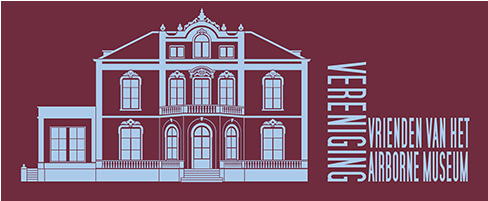
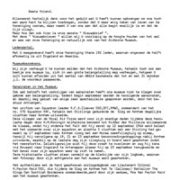
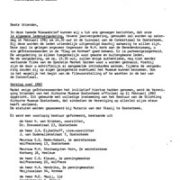
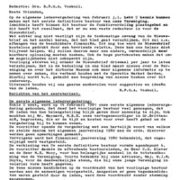
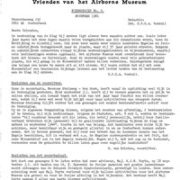
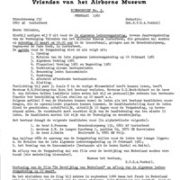
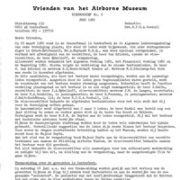
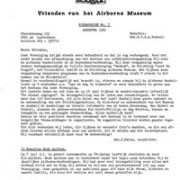
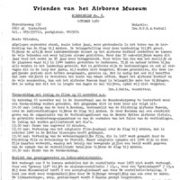
Plaats een Reactie
Vraag of reactie?Laat hier uw reactie achter.